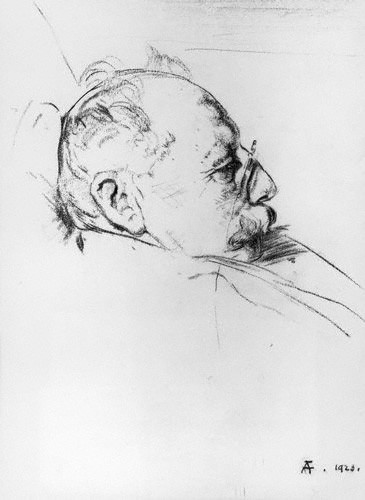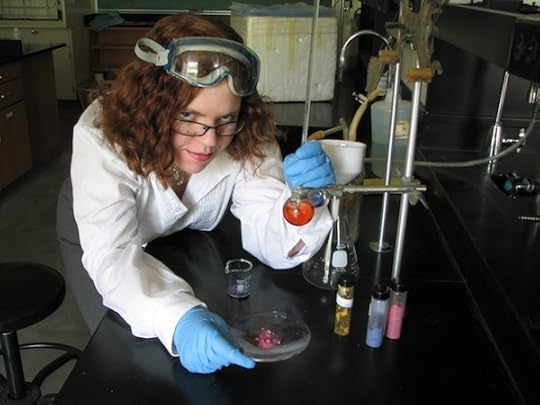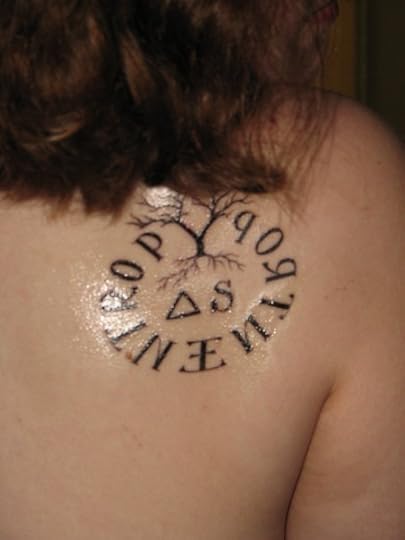Carl Zimmer's Blog, page 72
January 25, 2011
Another day, another grin: I'll be on WNYC's Brian Lehrer Show Wed. 11:45 am EST
 You can catch me on the Brian Lehrer Show on WNYC on Wednesday 1/26 at around 11:45 am, talking about the natural history of smiles.
You can catch me on the Brian Lehrer Show on WNYC on Wednesday 1/26 at around 11:45 am, talking about the natural history of smiles.

The ultimate case of TMI: Behold my bellybutton's microbiome
[image error]
Why is ScienceOnline a meeting like no other? Because it's the sort of meeting where a biologist named Rob Dunn can set up shop in the lobby to ask for samples of bellybutton shmutz that he can analyze for biological diversity. Not only is it a place where such a person will not be hustled out by security, but it's a place where a whole bunch of people respond by grabbing Q-tips to do their part for science. And you can bet every last bit of your bellybutton lint that I was right up near the front of the line.
Ten days later, my sample is now thriving nicely on a Petri dish, awaiting a more detailed analysis of its DNA. And here are the rest of the samples from the meeting.
All I can say is, #974, what is going on in there?
January 24, 2011
Talking smiles on The Takeaway Tuesday morning…
I'll be appearing on The Takeaway Tuesday morning to talk about smiles. I'll be on at some point between 6:20 and 6:40 am, and you can catch my segment again in the 8 am hour (EST). Soon after, it will be archived here.
Mysterious smiles and single-cell dogs: a double-header in tomorrow's New York Times
 I've got two stories in the New York Times tomorrow, at two ends of life's scales.
I've got two stories in the New York Times tomorrow, at two ends of life's scales.
In the cover story, I write about smiles. Faces have long fascinated me (see this Discover column on Darwin and Botox), and so I was intrigued to come across this recent paper focusing on smiles in particular. I talked to David Corcoran about the story for the first twelve minutes of the latest Science Times podcast.
Elsewhere in the Science Times, I keep up with the creepiest form of life out there: infectious cancer. Two species–Tasmanian devils and dogs–have given rise to cancer cells that can hop from host to host. I wrote about Tasmanian devils in the Times, and about dogs here at the Loom. Now there's news that the dog cancer (which I want to call Canis cancer after talking to the scientists who study it) rejuvenates itself from time to time by stealing its host's mitochondria. This is a story that just keeps going and going…like the cancer themselves.
January 22, 2011
"Treasure your exceptions"
 "If I may throw out a word of counsel to beginners, it is: Treasure your exceptions! When there are none, the work gets so dull that no one cares to carry it further. Keep them always uncovered and in sight. Exceptions are like the rough brickwork of a growing building which tells that there is more to come and shows where the next construction is to be."
"If I may throw out a word of counsel to beginners, it is: Treasure your exceptions! When there are none, the work gets so dull that no one cares to carry it further. Keep them always uncovered and in sight. Exceptions are like the rough brickwork of a growing building which tells that there is more to come and shows where the next construction is to be."
–William Bateson, in The Method and Scope of Genetics, 1908. [pdf]
January 19, 2011
Synthetic biology documentary in the making
I don't usually make pleas on the Loom. It doesn't suit my journalistic nature, and if I make a plug for one cause, it may seem like I am cruelly indifferent to all the other good causes out there. In this case, I'll just fall back on self-interest! A few weeks back two young film-makers, Sam Gaty and George Costakis, stopped by my house to interview me about synthetic biology for a documentary they're making on the subject. They've been filming across the country for the movie, but it won't finished in time for next year's Sundance unless they can raise a little scratch to get them through the summer. Over at the fund-raising site Kickstarter, Gaty makes the case–and offers a clip about goats making spider silk. If this movie doesn't get made, I end up on the cutting room floor. Oh, the humanity! (Actually, I think the film would be pretty cool without me–but judge for yourself.)

January 18, 2011
Requiem, revisited
 For nearly three years, the story of Abigail Garcia has woven its way through this blog.
For nearly three years, the story of Abigail Garcia has woven its way through this blog.
Back in April 2008, I got an email from Garcia, at the time an 18-year-old student at Reed College. I had started gathering science tattoos, and she had one she wanted to share.
"My first year of college, I wanted to be an English major," she wrote, "and I took Intro Chemistry to fill the science requirement. The brief unit on thermodynamics made me fall totally in love. Entropy made sense to me–-scientifically, philosophically. I became a Chemistry major and love every second of it. I got the tattoo to mark my rite of passage–Entropy going both ways, with its symble delta-S in the middle, all supported in the roots of Yggdrasil, the world-tree of Norse mythology (harking back to my English-lit days)."
 Three months later, her mother left a note in the comment thread for the tattoo. Garcia had died in a car crash. The thread became a condolence book, for people who had never met Garcia but who felt a link strong enough to want to offer their sympathies to her mother.
Three months later, her mother left a note in the comment thread for the tattoo. Garcia had died in a car crash. The thread became a condolence book, for people who had never met Garcia but who felt a link strong enough to want to offer their sympathies to her mother.
The thread fell silent for a year. But then Abigail returned, with a new comment from Sherrie. "On May 23, 2008, my mother had a double lung transplant," she wrote.
In 2009, Sherrie's mother set about finding out whose lungs she carried. She discovered they belonged to Garcia, and she received a letter about her from her mother, Tamara Thomas. "It was a little story of who her daughter was, and through her words, I felt as though I had a little glimpse of her daughter's spirit," Sherrie wrote.
"What two amazing women. One taken far too early in life and one to live on alone, but obviously imprinting that spirit in everything she does.When my mom finished reading the letter, of course crying the entire time, she said, I feel so honored to have been chosen to recieve such an amazing child's gift. We feel truly blessed, and honored, to have been given a second chance. I say we, because I am her caregiver and I went through every step of the transplant process with her. I can promise you, this gift will not be wasted."
The thread went quiet again for a few months, but came back to life in January 2010, when a friend of Abigail's at Reed stumbled across the post. "Ava, the name Abigail gave herself at Reed, was truly a pleasure to know," wrote lovereed. "She was a kind and remarkable girl, and I consider myself so lucky to have had her as a friend. I remember how excited she was about this tattoo, and it has always been one of my favorites. I think it's beautiful that Ava has given life to others, and the donation of her body to science and medicine embodies the selflessness with which she carried herself every day. I miss her constantly, and I will be carrying her with me when I cross the graduation stage this spring that she, too, was supposed to pass over."
Ava returned again in April of last year, in the memories of Lucky13. "I never met Ava, although I have met and assisted thousands of students in my nearly twenty year career as a university employee and now college programs manager," wrote Lucky13. "Ava was affiliated with a program that I now oversee and I had occasionally run across her name on historical lists in my files. All I knew about her initially was that she passed away while traveling to her internship at the Palo Verde Nuclear Generating Station. Then today, a rather dissatisfying work day, I again ran across her name on a list. And of an unexplainable reason, I decided I wanted to know more about Abigail Garcia. What I learned in reading brief information on only a couple of sites was that Abigail 'Ava' Garcia was nothing short of truly exceptional. In her brief and amazing life she demonstrated the power of intellect when combined with curiousity and passion; something not commonly found in today's youth. I smiled when I read that she had found an intellectual and emotional home at Reed College. I can only imagine how happy she must have been to be surrounded by others just like her–smart, inquisitive, and engaged in learning. And I could not help but cry at realizing all that was lost when she died. I wonder what she would be planning for her life at this time, the weeks before her graduation from Reed. Whatever it would have been, it would have been extraordinary–as was she. — Thanks to everyone who shared their story."
And today, almost three years later, Ava paid another visit, with a comment from her mother:
"I now share my daughter's tattoo. The symbol she designed marks the headstone of her grave. It will be three years this May that she left me, and the pain and loss is still fresh. I am grateful to have connected with some of her organ recipients; I have met the man in whose chest my daughter's heart beats. I have started writing about what I've termed my 'grief journey' [link--CZ] in hopes it might help others. There's not much out there for parents who lose children. Shoot, there's not even a name for us — not widow, not orphan — why is English so lacking here?"
Words do fail so often. But they suffice for me to say that Ava is always welcome to visit again. We will do our part to wind back entropy's grind, with memory and life.
[Thanks to Tamara Thomas for the image of Garcia]

Tonight's New Haven reading is cancelled
January is playing hardball with the Nutmeg State. The rain and melting snow are creating their own special havoc (including power cuts in some places in New Haven). So the Ordinary Reading Series has been cancelled and will be rescheduled for the spring–once we get all our Noreasters out of our system.

How many people are "not everyone"? Some thoughts on scientific debates and smackdowns
You may have heard about the new paper on how people tend to pick friends who carry a similar gene variant. If true, it would be very cool. But in Nature, Amy Maxmen quotes scientists who don't like the study at all:
"If this was a study looking for shared genes in patients with diabetes, it would not be up to the standards of the field," says David Altshuler, a geneticist at the Broad Institute in Cambridge. "We set these standards after 10 years of seeing so many irreproducible results in gene-association studies."
Because most genes have modest effects on behaviour or health, many scientists assume that thousands of SNPs — rather than six — need to be analysed before a correlation to any trait can be confidently made. Geneticists are often hard-pressed to find one SNP in a million that reproducibly correlates with a disease, says Altshuler. "It's like the team bought six lottery tickets and won the megabucks twice — this is not how things work."
Stanley Nelson, a human geneticist at the University of California, Los Angeles, agrees, adding: "It certainly is a provocative study — I would have loved to have seen it done with information from the rest of the genome."
Kudos to Maxmen to dig deep, rather than reprint a press release. But I found it odd that these critics were relegated to the end of the article, introduced with the following:
But not everyone is convinced.
I find this an annoyingly vague phrase. If a hundred experts read a paper and pass judgment, what does it mean for "not everyone" to be convinced? It sounds like it could mean 99 out of 100 love it, or 0 out of 100, or anywhere in between. If the quotations in the article are a representative sample, "not everyone" means "almost no one." In addition to Altshuler and Nelson, Maxmen quoted one other scientist who said it was an interesting study, "assuming it's right." Hardly a ringing endorsement. If almost no one thinks much of the paper, shouldn't that be the lead?
Maxmen faces a challenge for which there is no simple solution I know of. How does one report research? If it's gone through peer review, is it enough to just explain the results and wait until other scientists test them? Or does one seek out a criticism from an expert in the field, simply to demonstrate that "not everyone" is in agreement? And if you contact a lot of people and they mostly say a paper is no good, can you go further and make their collective judgment the story?
That's what I did recently when I reported for Slate on arsenic-based life: I got in touch with a bunch of scientists, almost all of whom criticized the paper. Is it true that "not everyone is convinced"? Well, yes, but it's also true that not everyone can bench press five hundred pounds.
In that case, I stand by my journalistic decision–especially given the emails I've since gotten from a number of experts who read the article and agreed with it, as well as the absence of a spirited defense of the paper from someone who's not a co-author.
But in other cases, the decision may be trickier. It's easy to find biologists who will criticize papers in evolutionary psychology–see, for example, University of Chicago evolutionary biologist Jerry Coyne rage about some recent stories.
Coyne writes, "You can bet your sweet tuchus that had Carl Zimmer written something like this, it would have included a lot more bet-hedging."
Leaving tuchuses aside (tuchi?), I read Coyne's post and wonder, how should bets be hedged? In the case of the friend-gene paper and the arsenic paper, the critics were getting into the details of how these kinds of studies are supposed to be done. But it seems that Coyne doesn't think that evolutionary psychology can be done, period–or at least, he thinks the whole field is pretty lousy. And since his post, evolutionary psychologist Robert Kurzban has counter-attacked, observing that Coyne and others hold evolutionary psychology to an unreasonable standard that they do not impose on other areas of research. My instinct in such cases is to write about a debate, rather than a critique. But there's no hard and fast rule about when a story shifts from one to the other. On that, everyone–not not everyone–should agree.

Tonight's reading with Annie Murphy Paul: Yes, most probably!
 Our very, very latest winter storm has warmed up into a rainy afternoon. Assuming that the roads don't proceed to freeze into ribbons of ice this evening, you will find me at 7 pm tonight in the Mermaid Room at the Anchor Bar, 272 College St., New Haven, for a free reading with author Annie Murphy Paul, as part of the Ordinary Evening Reading Series. Check back at the series site at 5:45 for our confirmation.
Our very, very latest winter storm has warmed up into a rainy afternoon. Assuming that the roads don't proceed to freeze into ribbons of ice this evening, you will find me at 7 pm tonight in the Mermaid Room at the Anchor Bar, 272 College St., New Haven, for a free reading with author Annie Murphy Paul, as part of the Ordinary Evening Reading Series. Check back at the series site at 5:45 for our confirmation.
[Image: New Haven Advocate ]













